The Thai people have an integral relationship with local markets and commerce. Whereas many people from industrialized nations such as the United States rely on supermarkets and grocery stores, Thai people have a more direct relationship with goods and resources. Local markets allow the common man to sell his or her own goods for a direct profit. Consumers benefit from this relationship as well because they can verify that the goods they are purchasing are fresh and high quality. Most of the vendors at markets are female because of the patriarchal ideal that men work the fields or on the fishing boats (perform the physical labor) and women take them to market. The goal of this collection is to bring the viewer into the visual world of Thai commerce using light as a guidepost.
While traveling through southern Thailand I found myself enchanted by the mundane. The haphazard quality of the buildings, infrastructure, and streets had their own unique, artistic flare. Nothing in Thailand is uniform; everything glistens with the beauty of the moment, the idea that all things created must deteriorate, and that function doesn’t always dictate organization. The marketplaces in Pak Phanang were my favorite visual representation of this idea because, for a few hours in the morning light, they take on an otherworldly (almost holy) aesthetic. The slapdash construction of the roofing at the market doesn’t need to be changed because this is what imbues the space below with such an enchanting quality. Otherwise mundane holes in the ceiling become brilliant oculi for golden sunlight, and this luminance is what I sought.
-

Market Pendulums
The Thai people certainly have a love affair with plastic bags, which can be described as ubiquitous. From markets, to mangroves, to the open ocean: plastic bags can be found everywhere.
-
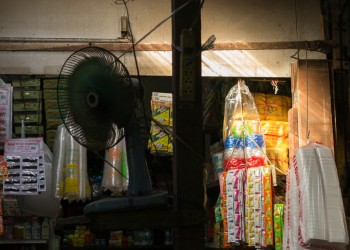
Dry Goods
Pak Phanang, the location for this particular market, was first given its name (meaning Sheltered Mouth) as early as 1665, but was officially named so in 1903. The wide river that runs through the district predestined the location to become a thriving port city. During the 19th and early 20th centuries this district was the rice bowl of the far South. Its strategic location near the mouth (pak) of the Phanang River made it easy for ships to dock and load up with hulled rice from the steam-powered mills that line the waterway.
-
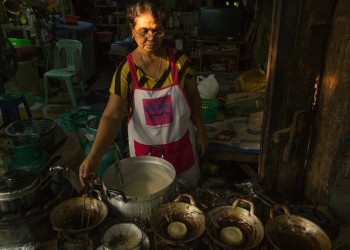
Woman Cooking
Fresh foods are commonplace in Thai markets.
Here we see a woman frying up a traditional Thai sticky-rice dough called "Khanom Juu-Jun" for customers to purchase fresh from the frying pan.
-

Fresh Catch
It is rather common for fish vendors to remove the cartilage lined flap that covers the gills to reveal the gill membrane underneath. If the gills are a bright red this indicates the presence of blood circulation, which means the fish are quite fresh.
-

Market Light
This particular market in Amphoe Pak Panang was striking because of its dilapidated construction. Wires run everywhere above, the ceiling a patchwork of various roofing materials, holes, and the occasional skylight or open shaft. These skylights allowed vendors to more visibly display their wares without the assistance of electric lighting (sometimes a luxury). Each skylight creates its own unique imprint on the otherwise mundane scene below, adding an almost otherworldly or sacred glow to the marketplace.
-

35 baht
Woman selling fruit and dried goods in the market at 7:45 in the morning. The markets in Pak Panang are usually the most busy during 6:30am-9am due to the blazing Thai heat. Most vendors and shoppers alike prefer to buy their food early in the morning to beat the heat, but also because fish and other seafood are caught early morning and sold the same day.
-
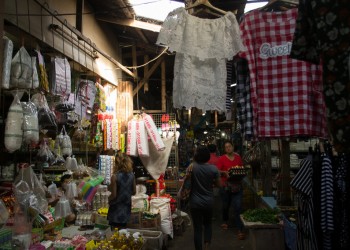
Women Shopping
The women at this local open air market browsing the dried goods and fresh produce. Local vendors also sell eggs, meat, clothing, make-up, toiletries, and shoes.
-

Fresh Gulf Crabs
When the men come in from making their catch in the early hours of the day the women prepare their spoils and take them to market. The women may be at the market from as early as 7 or 8 in the morning to as late as 6 or 7 in the evening, depending on business.
-
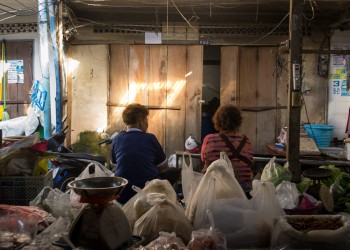
Shop Talk
Two women managing a shop enjoy the shade and converse. Men usually are absent from these scenes because Thai culture dictates that usually men do the physical labor (farming, fishing, etc) and women take the harvest to market.
-

Vendor & Light
From an interview of a Pak Phanang local: ''Commercial vessels no longer tie up along here,'' said Paisarn Wipoosanapat, a local resident, ''but we've preserved the old wooden shophouses and I think the atmosphere is similar to what it must have been like in the past.'' (KARNJANATAWE)
-
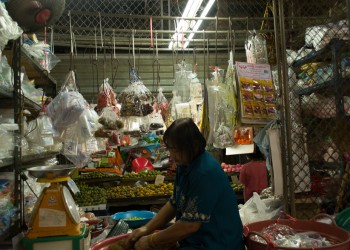
Flora For Sale
King Chulalongkorn, who paid a visit in 1906, near the end of his reign, is on record as saying: ''I had been aware of the importance of this district, but ... it far exceeded my expectations. I had not imagined it [to be] so big and so rich. The river is about as wide as the Chao Phraya at ... Bangkok. It has fertile rice lands, even more so than those in the Rangsit canal area. And there is enough unused land to increase tenfold the area now under rice here. None of the ports on the eastern coast of the Malay Peninsula can hold a candle to Pak Phanang.
-
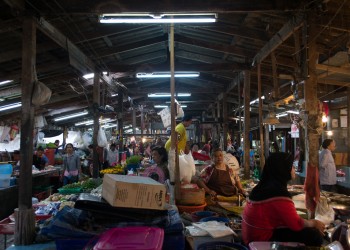
Cathedral
The thriving nature of local thai markets helps keep money circulating within the local economy. Where many industrialized countries rely on more corporate vendors, local marketplaces help keep Thai people connected nearby resources and minimize their dependence on imports.











